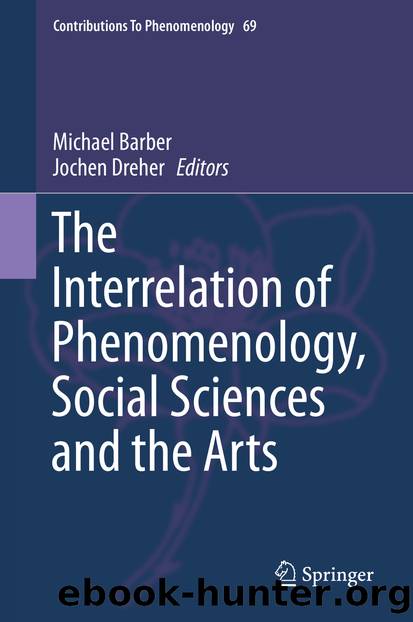The Interrelation of Phenomenology, Social Sciences and the Arts by Michael Barber & Jochen Dreher

Author:Michael Barber & Jochen Dreher
Language: eng
Format: epub
Publisher: Springer International Publishing, Cham
3 Berger’s Study
It is Berger’s aim to apply Schutz’s (1945) concept of multiple realities to Musil’s description of the “other condition” in the second part of The Man without Qualities. According to Berger a “relativization of everyday reality” is the presupposition for entering the “other condition” (Berger 1978, p. 354). This seems to be a typically Schutzian strategy to analyze the shock taking place by moving from one multiple reality to another.
In doing so, Berger first argues that the paramount reality of everyday life “persists in its massive facticity even after various breakdowns in the fabric of ‘normality’” (Berger 1978, p. 345). Furthermore, everyday life while “experienced as a totality” is divided into “different social worlds,” (Berger 1978, p. 345) “the transition from one of its sectors to another can be experienced as a shock.” (Berger 1978, p. 346). In addition to this “differentiation within everyday reality” Berger also identifies a world “beyond the domain of everyday reality,” the transition to which causes an even greater shock (Berger 1978, pp. 346–348).4 I agree with Berger that it is Ulrich’s insight into the social construction of everyday reality through which this reality to him “becomes problematic as a whole,” (Berger 1978, p. 348) while he reveals it “as a tenuous balancing act between a multiplicity of forces.” (ibid.)
But while Berger tries to focus on “the other condition” (“anderer Zustand”) as “Ulrich’s central concern,” (Berger 1978, p. 348) reading it as being in opposition to everyday life, he analyses Musil’s novel under the premise that “all these transition points [i.e. all “possible transfer stations to the ‘other conditions’”] have in common a violent breakdown of the taken-for-granted routines of everyday life.” (Berger 1978, p. 348). According to this phenomenon Berger (1978, p. 348) also speaks of an “abolition,” (“Abschaffung”, see Musil 1978a, p. 365) an “absurdity” (Berger 1978, p. 349) of reality, of a distancing from the “theatrum mundi,” (Berger 1978, pp. 348, 350) of “breakdowns of the fabric of normality,” (Berger 1978, p. 345) of “violent” interruptions, and he argues that in the state of the “other condition” “no experiencing of the world” takes place (Berger 1978, p. 355) and that this “reality … haunts the reality of everyday life.” (Berger 1978, pp. 343f.) Berger’s descriptions here imply several ontological connotations, which also become obvious when he argues that “the ‘other condition’ lies on the other side of this abolished reality” as a “novel and strange mode of being” (Berger 1978, p. 348).
Furthermore, Ulrich, who, as we learn in the beginning of the novel, “had returned from abroad sometime before,” has now settled in Vienna and “for a certain exuberance” rented a “little château,” (Musil 1995, p. 8; cf. Musil 1978a, p. 13) because, as he “could not conceal from himself that in all those years […] he had merely been living against his grain. He wished something unforeseen would happen to him, for when he took what he somewhat wryly called his ‘holiday from life’ he had nothing […], that gave him peace” (Musil 1995, p.
Download
This site does not store any files on its server. We only index and link to content provided by other sites. Please contact the content providers to delete copyright contents if any and email us, we'll remove relevant links or contents immediately.
| Anthropology | Archaeology |
| Philosophy | Politics & Government |
| Social Sciences | Sociology |
| Women's Studies |
The remains of the day by Kazuo Ishiguro(8748)
Tools of Titans by Timothy Ferriss(8157)
Giovanni's Room by James Baldwin(7117)
The Black Swan by Nassim Nicholas Taleb(6948)
Inner Engineering: A Yogi's Guide to Joy by Sadhguru(6633)
The Way of Zen by Alan W. Watts(6452)
Asking the Right Questions: A Guide to Critical Thinking by M. Neil Browne & Stuart M. Keeley(5577)
The Power of Now: A Guide to Spiritual Enlightenment by Eckhart Tolle(5544)
The Six Wives Of Henry VIII (WOMEN IN HISTORY) by Fraser Antonia(5358)
Astrophysics for People in a Hurry by Neil DeGrasse Tyson(5095)
Housekeeping by Marilynne Robinson(4253)
12 Rules for Life by Jordan B. Peterson(4218)
The Ethical Slut by Janet W. Hardy(4147)
Double Down (Diary of a Wimpy Kid Book 11) by Jeff Kinney(4145)
Skin in the Game by Nassim Nicholas Taleb(4123)
Ikigai by Héctor García & Francesc Miralles(4044)
The Art of Happiness by The Dalai Lama(4009)
Skin in the Game: Hidden Asymmetries in Daily Life by Nassim Nicholas Taleb(3868)
Walking by Henry David Thoreau(3858)
